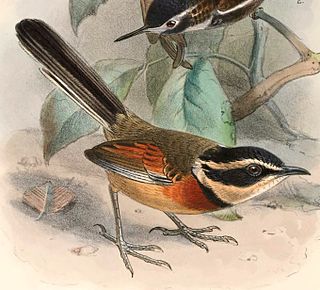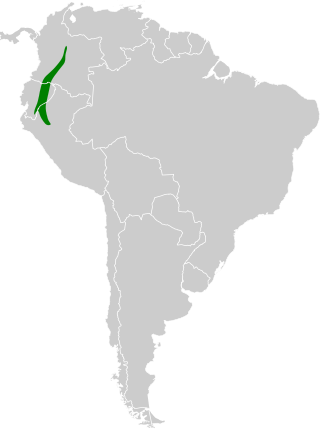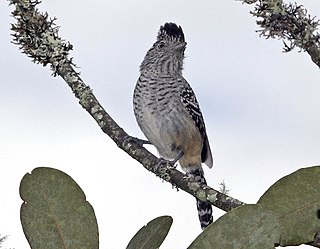
The white-fronted nunbird is a species of near-passerine bird in the family Bucconidae, the puffbirds, nunlets, and nunbirds. It is found Bolivia, Brazil, Colombia, Costa Rica, Ecuador, Honduras, Nicaragua, Panama, Peru, and Venezuela.

The white-headed wren is a species of bird in the family Troglodytidae. It is found in Colombia and Panama.

The giant wren is a species of bird in the family Troglodytidae. It is found in Mexico and Guatemala.

The bicolored wren is a species of bird in the family Troglodytidae. It is found in Colombia, Venezuela, Guyana, and Brazil.

Boucard's wren is a species of bird in the family Troglodytidae. It is endemic to Mexico.

The gray-barred wren is a species of bird in the family Troglodytidae. It is endemic to Mexico.

Apolinar's wren is a passerine bird in the family Troglodytidae. It is endemic to Colombia.

The fasciated antshrike is a species of bird in subfamily Thamnophilinae of family Thamnophilidae, the "typical antbirds". It is found in Central America from Honduras south and in every mainland South American country except Argentina, Chile, Paraguay, and Uruguay.

The pearled treerunner is a species of bird in the Furnariinae subfamily of the ovenbird family Furnariidae. It is found in Bolivia, Colombia, Ecuador, Peru, Venezuela, and possibly Argentina.

The elegant crescentchest is a species of bird in the family Melanopareiidae. It is found in Ecuador and Peru.

The southern nightingale-wren, also known as the scaly-breasted wren, is a species of bird in the family Troglodytidae. It is found in Bolivia, Brazil, Colombia, Costa Rica, Ecuador, Panama, Peru, and Venezuela.

The grey-mantled wren is a species of bird in the family Troglodytidae. It is found in Bolivia, Colombia, Ecuador, and Peru.

The dusky spinetail is a species of bird in the Furnariinae subfamily of the ovenbird family Furnariidae. It is found in Colombia, Ecuador, and Peru.

The necklaced spinetail is a species of ovenbird in the family Furnariidae. It is found in Ecuador and Peru.

Chapman's antshrike is a species of bird in subfamily Thamnophilinae of family Thamnophilidae, the "typical antbirds". It is found in Ecuador and Peru.

The plain softtail is a species of bird in the Furnariinae subfamily of the ovenbird family Furnariidae. It is found in Bolivia, Brazil, Ecuador, and Peru.

The speckle-breasted wren is a species of bird in the family Troglodytidae. It is found in Colombia, Ecuador, and Peru.

The superciliated wren is a species of bird in the family Troglodytidae. It is found in Ecuador and Peru.

The mountain wren is a species of bird in the family Troglodytidae. It is found in the Andes of northwestern Argentina, Bolivia, Colombia, Ecuador, Peru, and western Venezuela.

The Andean flicker is a species of bird in subfamily Picinae of the woodpecker family Picidae. It is found in Argentina, Bolivia, Chile, Ecuador, and Peru.






















